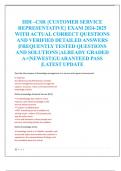Exam (elaborations)
HDI –CSR {CUSTOMER SERVICE REPRESENTATIVE} EXAM WITH ACTUAL CORRECT QUESTIONS AND VERIFIED DETAILED ANSWERS |FREQUENTLY TESTED QUESTIONS AND SOLUTIONS |ALREADY GRADED A+|NEWEST|GUARANTEED PASS |LATEST UPDATE
- Course
- Institution
HDI –CSR {CUSTOMER SERVICE REPRESENTATIVE} EXAM WITH ACTUAL CORRECT QUESTIONS AND VERIFIED DETAILED ANSWERS |FREQUENTLY TESTED QUESTIONS AND SOLUTIONS |ALREADY GRADED A+|NEWEST|GUARANTEED PASS |LATEST UPDATE
[Show more]



